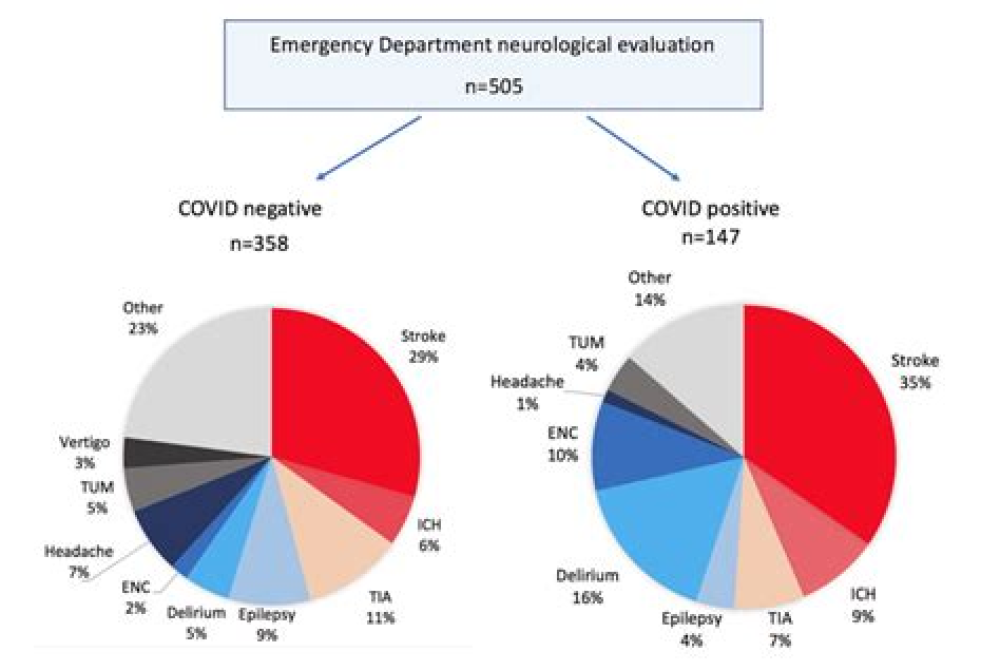Authors: Piotr Tekiela, View ORCID ProfileJennifer J. Majersik
One of the greatest challenges of treating a new virus is the lack of information about it. When little is known about a virus, patients affected by it, as well as their families, are left with uncertainty. In an article appearing in this issue of Neurology®, Dr. Frontera and her team aimed to determine how often patients hospitalized with coronavirus disease 2019 (COVID-19) developed new neurologic disorders.1 They then compared several key outcomes in treatment between patients who developed a new neurologic disorder due to COVID-19 and those who did not. These included discharges to home, ventilator use, length of hospital stay, and in-hospital deaths. These findings can help us understand which groups of people may be more likely to develop more severe disease after having COVID-19, as well as what their prognosis is likely to be.
How Was the Study Done?
The study was run during the first wave of the COVID-19 pandemic, from March 10 through May 20, 2020, in 4 hospitals in the New York City metropolitan area. The researchers set strict guidelines for the type of patients they would include in the study. Patients had to be adults with a laboratory-confirmed severe acute respiratory syndrome coronavirus (SARS-CoV-2) infection. They also had to have been admitted to the hospital at some point during the duration of their illness. Patients who were only seen in an emergency department or at an outpatient clinic were not included in the study.
There are 3 major strengths of this study that set it apart from other studies. First, patients were excluded if they were not tested for SARS-CoV-2 or if they tested negative for the virus. Second, all of the neurologic diagnoses made during the study were determined by a neurologist. Lastly, only new diagnoses of neurologic disease were included in the study. If someone had a neurologic disorder that was known before hospitalization due to COVID-19, that diagnosis was not counted in the study results. This improved the accuracy of diagnosing new neurologic complications that appeared to be caused by COVID-19.
What Were the Results?
A total of 4,491 patients were hospitalized with COVID-19 at the 4 hospitals involved in the study. Of those patients, 606 (13.5%) developed a new neurologic disorder, as diagnosed by a neurologist. These disorders included a confused state in 51% (called a toxic-metabolic encephalopathy), stroke in 14%, seizures in 12%, and brain injury due to lack of oxygen or blood flow (called hypoxic or ischemic disorders) in 11% (see below to learn more about these disorders). The researchers did not find any infections in the brain (such as meningitis or encephalitis) or in the spinal cord (myelitis) in these patients. The patients at highest risk of developing a neurologic disease were older and more likely to be male, White, or diabetic.
For most patients (54%) who developed a neurologic disorder, the disorder appeared about 2 days after the initial COVID-19 symptoms (fever, cough, nausea, vomiting, or diarrhea) arose. In 43% of patients, neurologic problems developed at approximately the same time as their initial COVID-19 symptoms. Only 2% of patients developed neurologic symptoms before onset of the common COVID-19 symptoms.
Development of new neurologic disease was associated with worse outcomes overall. Patients who developed a neurologic disorder along with COVID-19 were 28% less likely to be discharged home from the hospital and 38% more likely to die (either from the illness or from the neurologic disorder). Further, they spent 6 more days on a ventilator and 4 more days in the hospital than patients who did not develop a new neurologic disorder.
For More Information: https://n.neurology.org/content/96/4/e647
